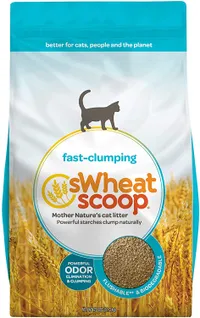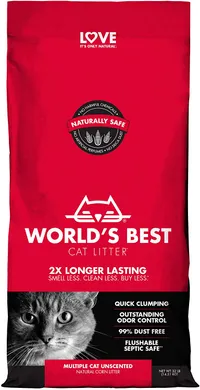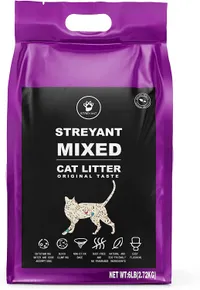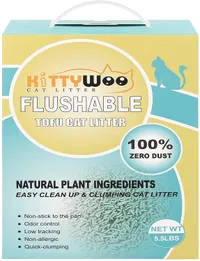Flushable cat litter: Should you use it?
Invest in flushable cat litter and you'll enjoy the convenience of disposing of it but at what other cost?
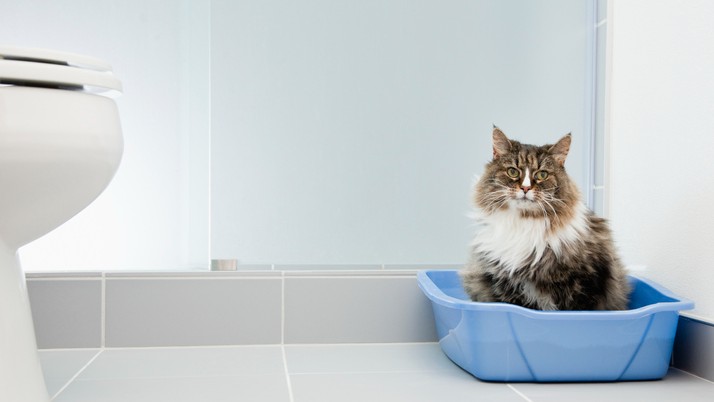
It seems like a great deal: buy flushable cat litter and you won't have to worry about bagging up your kitty's poop, dropping it in the bin and eventually sending it to landfill. In that sense, it sounds like it's going to be the best cat litter money can buy – not only does it appear convenient but kind to the environment. After all, you flush your own poop down the toilet so why not do the same with your cat's waste too?
The reality is a little more complicated than that but there's no denying that there's a whole industry centered around making it easier for you to deal with cat litter. Companies compete to offer the best self-cleaning cat litter boxes, for instance, and you may ponder buying one of the best cat litter subscriptions. In such cases, you'll still need to consider how you're going to dispose of the trays or empty the bins but if you're looking to avoid the trashier of tasks, is cat litter flushable?
- 8 DIY cat litter box ideas
- Do you know how often to change cat litter?
- Types of cat litter: Which one is right for your feline?
Pros of using flushable cat litter
Traditional litter certainly isn't designed to be thrown down the toilet. It absorbs water and expands hugely so you can imagine the damage it's going to do to the pipes in your home if you try to flush it away. Plumbers may rub their hands at the thought of a bumper pay day if you dispose of normal litter in this way but flushable litter claims to be different. How so?
Flushable cat litter is made of natural, compostable materials such as wheat, newspaper, cassava, pine, wood shavings or corn. Since the material is biodegradable, it will be broken down by micro-organisms, fungi or bacteria over time, allowing it to blend back in with the earth. As such, manufacturers say it's fine to pop the soiled litter down the toilet, flush and send it on its merry way.
Some of those materials – wood, corn and cassava, in particular – also naturally control odor (although (cats can be allergic to corn and wheat). Pine and cedar, for instance, add a fresh smell that hides the stench of feces but manufacturers will generally help mask odors in other ways, perhaps by adding baking soda. The major advantage of flushable cat litter is always going to be convenience, though.
Is Flushable cat litter really eco-friendly?
If you're comparing it to traditional cat litter then yes, it is. Resoundingly so. Clay is typically used for cat litter but it is strip mined which has environmental consequences. It causes air and water pollution, soil erosion and disturbs animal habitats. Clay isn't biodegradable either so it ends up filling landfill sites.
Once you've cracked how to get a cat to use a litter box, you'll have no such problems with flushable cat litter in and of itself. But the question is really whether or not you should actually flush it away. In all truth, no. It may seem crazy that a product which advertises itself as flushable shouldn't actually be sent through the pipes but there is very sound reasoning for that.
Get the best advice, tips and top tech for your beloved Pets
Your home's plumbing can still become clogged by flushable cat litter (and even hardened poop), particularly so if you are using a septic system. You could tip the litter away bit by bit and keep flushing but that's hardly eco-friendly even if it could resolve one problem (you may find having to flush even more if you have a water-saving toilet).
Cat feces is also bad for the water system because it can contain a parasite called Toxoplasma gondii which causes toxoplasmosis. Most waste treatment plants can't get rid of it so it could end up in the water system or, just as bad, flushed out to sea. It's why it is banned in some American states such as California to protect fragile marine wildlife.
Should you buy flushable cat litter?
But should you still consider buying flushable cat litter if you can? Yes. Just because it is flushable doesn't actually mean you have to flush it. You could pop the litter in a paper bag and send it to landfill knowing that it will biodegrade. You may not benefit from a cat litter that clumps and it may go against its main advantage of offering convenience but you will at least go some way towards protecting the environment and that is hugely important too.
Top 5 Flushable Cat Litters
sWheat Scoop
Made from wheat, sWheat easily clumps while also eliminating odors. Certified flushable by independent researchers, the SGS US Testing Company, the manufacturer advises scooping the litter box daily, scooping clumps into the toilet and letting them soak for 20 minutes.
World's Best Cat Litter
It's a fine boast to plaster across the front of the packaging but although it's not cheap, this cat litter is made from whole-kernel corn which offers great odor control. It also claims to be flushable one or two clumps at a time, even when used with septic systems.
Cat's Pride Scented Flushable Clumping Litter
This lightweight litter is actually made by porous clay which the maker says has passed rigorous tests for flushability, two clumps at a time. It doesn't contain any harsh chemicals and it's free from overpowering fragrances although it does control odor.
Streyant Mixed Cat Litter
Made from soybean and clumping clay, Streyant's offering will let you flush clumps that are less than three inches (eight centimeters) although it does suggest chucking it in the trash can if your home's pipes are old.
KittyWoo Tofu Cat Litter
This cat litter is made from edible corn and peas which dissolve within two seconds when it comes into contact with water. Since it clumps, it's easy to scoop away the feces and the maker says it can also be eaten by cats, albeit in small amounts.
You might also want to read: How to reduce cat litter smells.

David Crookes has been a journalist for almost 30 years and he has written for a host of magazines, newspapers, websites and books including the World of Animals Annual, BBC Earth, Live Science, The Independent and Tom’s Guide.
Born in England, he lives with two cats but he’s also keenly interested in the differences between the huge number of dog breeds – in fact, you can read many of his breed guides that he’s written in collaboration with vets here on PetsRadar.
With a lifelong passion for technology, too, he’s always on the lookout for useful devices that will allow people to keep their pets happier and healthier, and provide them more time to spend together.
David has a degree from Durham University, as well as postgraduate diploma in journalism from the University of Central Lancashire.
